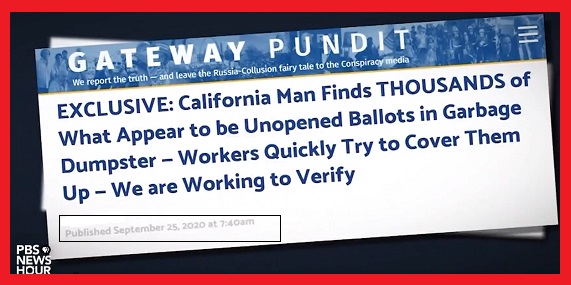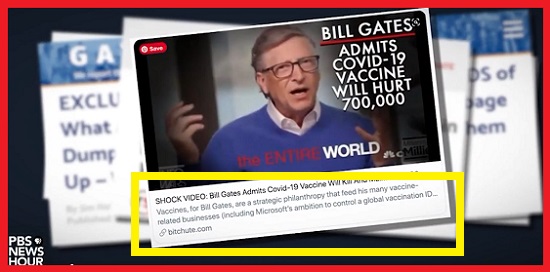A fine and timely article from ABC News with this headline:
“Why
millions don't trust the election results, despite no evidence of fraud”
Lead Question: “What is it
about the human psyche that makes us so susceptible to disinformation
surrounding this election run-up and outcome?”
Short Answer (more details below): It has less to do with the content
of the information and more to do with the social identity of the person.
Reminder: Difference between misinformation & disinformation.
Misinformation: Information that is placed by a simple mistake not covertly and not with malice, intent, or
purpose.
vs
Disinformation: Information that is purposely placed with the full
intent to cause harm, disruption, distrust, and chaos. Mostly in modern times
used to covertly disrupt or topple established governments, competing political
systems around the globe for self-interests, and for political, military,
financial, or more devious purposes.
Related to the ABC story is this
6-minute
PBS New Hour video.
So, what's driving some of these
inclinations is about who people feel they are, what groups they're associated
with, who they identify themselves as, who they identify with others as, and
why.
Background: As of Friday
(November 20), Joe Biden has nearly 80 million votes. That number is some 10
million more than the previous record set by Barack Obama in 2008.
Donald J. Trump also eclipsed
Obama's record with his nearly 74 million votes at last count.
Those numbers were propelled in
part by record mail-in voting, which was predicted to be historically high, due
to the virus pandemic.
Election fraud is what
Trump and his allies have and continue to throw around and claim without
evidence, and which to date over 30 court cases Trump has filed have disagreed,
and several he withdrew from in advance or while they were in progress.
Fueling that false doubt is the
fact that Trump appeared to lead in several key states on election night, only
to see those leads reversed when mail-in ballots were counted – again with high
numbers as everyone predicted would happen and did.
Trump has been relentless in
attacking the ballot-counting procedures in several key states ever since
Election Day. But, it is not unusual to see an early leader fall as more and
more votes are counted.
Political parties in the
United States have become increasingly correlated with two distinct cultures
defined by religious identity, racial identity, and geographic location.
As a result it’s easier to
create a false story that taps into those identities, making one side or the
other more likely to believe it or not.
Add to that political
environment is the fact that we’re living through an historical pandemic.
People are extremely
anxious and uncertain about the future, and that makes for a perfect storm of
conditions to sow disinformation.
Experts who study
human nature almost all say that “…if
you just feel like things are out of control, that that can be really
debilitating. So people want to impose order on the world. So, if someone
offers a wild theory, even though it might not be logical, you’re more likely
to believe it because it helps explain your situation and give you control. Accompanying
that is the deepening divisions in the U.S. is anger and distrust of the others
side. It seems counterintuitive, but anger makes people feel optimistic because
anger has a forward driving momentum.”
People are more likely to
believe something that aligns with how they see the world but argues that
there’s a much simpler reason for why people fall for disinformation.
People are cognitive
misers, which means the brain will always look for the simplest solution to a
problem. That is especially true when applied social media – quite simple: people
just don’t take the time to analyze the information properly.
People if asked to stop
and think about if this or that is true or not, most people are actually pretty
good at telling the difference between fake news and true news. Where the
information comes from also influences how likely people are to believe it
because they are more likely to believe information from people that they trust
as reliable.
People can have something
that they find really surprising that doesn't fit their previous beliefs at all,
too. If it's from a source they really trust, then they think, OK, I guess I was
wrong.
Whereas if it's from a
source you think is sketchy, then you're like more likely the source is wrong
than everything I know about the world is wrong. As a result of media coverage,
people also are more aware of disinformation but nobody seems to think they
will ever be duped by it- the so-called “third-person effect.”
That simply means everyone is
susceptible to disinformation while thinking they are not, and that that’s a
logical fallacy because they can't all be right or it wouldn’t be a problem.
If someone believes
they’re immune to disinformation it means it will be very difficult to change
their minds once they’ve taken hold of a false narrative.
Research suggests that debunking
a falsity can actually have the opposite effect and help propagate the original
falsity if not done properly. Debunking can be done using the truth sandwich
effect, whereby you preface the falsity with what is true, discuss the false
allegation, and then reiterate what is true.
Introducing a speed bump that
forces people to think more about the information they consume, like the
warning labels platforms like Twitter and Facebook have begun to place on false
or misleading posts, are proven to lessen the spread of those posts.
There are several papers now showing if you just put a warning on
something when people first see it, it makes them less likely to believe it and
less likely to share it, regardless of whether it aligns with their ideology or
not.
The above medical and scientific facts and opinions come from two well-known
experts:
* Dannagal Young, political psychologist and
associate professor at the University of Delaware
* Dr. David Rand, a cognitive scientist at M.I.T
This last one just for good measure:
My 2 cents: All of this
information pretty much stands alone and explains a lot about who we are today,
which sadly shows we are a very divided country across many lines.
The information also shows
the lack of high level of education or a basic understanding of human nature
and thinking regarding what and how to believe and trust information. Also, sad
is many people lack the skill to research beyond a narrow field of information sources,
and that is very dangerous approach.
That is why a person
should always check more than one source for their news and information. I’d
say use 3-4 sources. That’s the rule thump that I use. Sure, it takes more time,
but getting the facts and truth straight is the object isn’t it?
Thanks for stopping by.





No comments:
Post a Comment